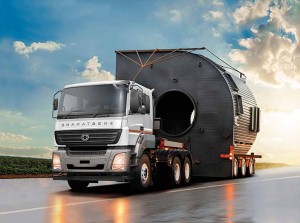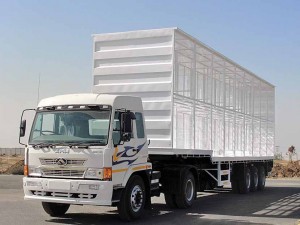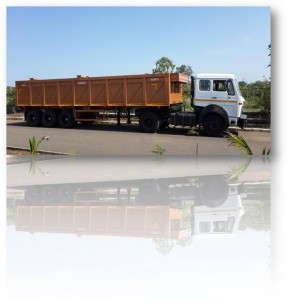The (truck) trailer segment in India is optimistic about growth. It is looking at outperforming its global peers over the medium- and long-term.
Story by:
Ashish Bhatia
The cancellation of Rs.500 and Rs.1000 notes under the guise of ‘demonetisation’ may pose a challenge to the Indian transportation sector, a big chink of which includes the trucking industry, the fact is, the truckers have not lost hope yet. According to the All India Motor Transport Congress (AIMTC), there are an estimated 9.3 million truckers in India. Of these, the number of heavy-duty trucks is increasing year-on-year. There is a distinct movement happening towards higher tonnage trucks. The ban on overloading is driving transporters to look at bigger, multi-axle trucks that can carry more. While October 2016 marked a month of growth for Medium and Heavy Commercial Vehicles (M&HCVs), the sale of truck-semitrailers and truck trailers is on the rise. Rajasthan continues to be the biggest truck-trailer market; Haryana continues to be the biggest car carrier market. The effect of demonetisation may be evident on truck trailer operators, they continue to see growth in the scope of their vision. Industry experts are also optimistic about the growth of truck-trailer segment. This growth, they claim, will ensure that the trailer industry, which is both, organised and unorganised, will post good growth. Truck code may take time yet, and until then, the unorganised bit of the trailer industry may not have a reason to worry about. That does not eliminate their responsibility to build safe and high quality trailers; the fact is, the trailer industry in India is looking at outperforming its global peers over the medium- and long-term.
Cyclical in nature
A highly cyclical market in India, according to Neha Tayal, Research Manager – Automotive Division of TechSci Research, the Indian trailer segment has been growing. Though it may contribute a mere 10 to 12 per cent of the total commercial vehicles sold in India, it has been growing. Said Tayal, “The segment holds the potential to grow at a Compounded Annual Growth Rate (CAGR) of seven to eight per cent, over medium- to long-term. Rajeev Batra, Chief Operation Officer, Tata International DLT Pvt. Ltd., is also of the opinion that the trailer market is looking up. He attributes the growth potential of the trailer market to the focus the government is putting on meeting safety and other standards. Mentioned Batra, “The trailer market growth in FY2016-17 and 2017-18 will be in the region of 10 per cent to 15 per cent respectively.” The trailer market has been growing in 2016. In 2015, it posted a consistent recovery. The recovery started in 2014 after recording the lowest sales in 2013. Till 2020, the trailer market in India is expected to grow at a rate of 10-15 per cent annually. The Indian trailer market is claimed to range between 18,000 and 20,000 units per annum. The market for overburden tippers is said to be between 3,000 and 4,000 units per annum.
Complex market
(Truck) trailer market in India is complex. Over 80 per cent of the market is made up of unorganised players. Many of these are regional players that address regional operator requirements. Players like Tata DLT and Satrac Engineering are part of the 20 per cent organised market. They have been carving out a larger share of the trailer market. Tata DLT, in FY2015-16, sold over 39,000 trailers across various applications such as mining, cement, road construction and material movement among others. According to Batra, the company commands six per cent of the market share in trailers. The mix of business at Tata DLT is the OE business and the aftermarket business. Tata DLT makes trailers to be offered along with Tata Motors’ prime movers like the Tata LPT 4018. It also makes trailers for special application like tip trailers, curtain trailers, running gears, etc., to address the specific needs of the operators. The manufacture of a trailer is a complex task, claimed an industry expert. It is the components (axles, suspension, etc.) used in the manufacture of a trailer, which makes it a complex task, he said. Depending on the nature of application and how much a trailer buyer is ready to spend, organised players like Tata DLT offer York axles, BPW axles, or Fuwa axles. At unorganised players, cost is said to be a prime criteria.
(Truck) trailer types
(Truck) trailers are broadly classified on the basis of the number of axles they are fitted with. They could have two or more axles. The number of axles is correlated to the load carrying capability of the truck-trailer. It is also connected to the application the truck-trailer is meant to address.
Sidewall trailers and bulkers are used for cement based applications. They constitute 30 to 35 per cent of the overall trailer market. The flatbed and well bed trailer, deployed for steel and steel-coil movement along with skeletal trailer for container movement make up the majority of the (truck) trailer market. They account for 40 per cent to 45 per cent of the market share cumulatively. Tip trailers and tank trailers, catering to road infrastructure, make up 20 per cent of the segment. An estimated two-to-three per cent segment share is made up of Over Dimensional Cargo (ODC) carriers. A minuscule chunk of (Truck) trailers also finds use in highly specialised application areas; they could be fitted with racks, curtains, etc., or heavily customised. A part of the trailer market are also the motor carriers, which ferry cars, two wheelers, trucks and buses from the plant to a dealer. These are often found be as long as 22.5 m. If an industry expert is to be believed, the Government of India recently capped the length of such carriers to 18.75 m. Said S.P. Singh, Senior Fellow, IFTRT, “Driving a good per centage of M&HCV sales are vehicles that move cars and SUVs. Continuing double digit growth of two wheelers (and four wheelers) is also necessitating the need for carriers. Capping the length at 18.75 m instead of 16 m may pose safety issues.”
Regulatory environment
If the lack of regulatory environment helped the unorganised trailer market to mushroom, it is no longer the case. Regulatory environment is kicking in. The capping of the length of motor carriers at 18.75 m is just the start, said an industry expert. He added, the truck code will set things right; will ensure safety and environmental compliance in the case of trucks. Avvered Ranjit Singh, Punjab Transport Company, “The approval of trailer type code AIS 113 will not only improve the safety norms, it will also drive professionalism and turn trailer makers into organised players.” Batra informed, “The trailer type code AIS11 will go beyond the enhancement of existing safety norms.” Overloading and overspeeding ar the two issues regarding truck-trailers that need to be addressed. The need is to change the operator mind set; to strictly implement the apex court’s order to ban overloading. Stricter policing is helping, toll road companies are getting more aggressive in combating overloading since such vehicles damage their roads. Facilitating the carriage of more load, truck-trailer operators are sadly not immune to the problems faced by others, including delays at state borders and limited availability of infrastructure. Drawing attention to the fact that a truck-trailer has difficulty operating over narrow roads, the industry expert claimed, that the pressure to break even for a truck-trailer operator is high. His focus is therefore bound to be on higher utilisation. Expressed Kulwant Singh of Hundal Trailer Service, “The cost of trailer transport is competitive, and has the potential to cushion the industry from slowing down.”
Safety and road infrastructure
Safety concerning truck-trailers is perhaps the most debated subject. Safety and better returns in the case of trucks are tied to infrastructure. Stated Tayal, that the lack of adherence to adequate safety compliance has attributed to the country’s substandard road and traffic conditions. Testimony to it is the substantially higher rate of casualties, at both the loading facilities as well as on the roads.” Mandatory ABS on heavy trucks has been an effort to elevate road safety. Claimed an industry expert, that there is a need to maintain the trailer, ensure that its braking system, lights and other mechanisms (like the container lashing mechanism) are in good working condition.
Need to standardise; to grow
Stress on standardisation is being laid to ensure that the trailer market grows. Said Batra, “Standardisation of input will certainly facilitate a better return to the transporter in the form of mileage, longer life of trailer and improved operating economics. The cost of transport, which is highly competitive when it comes to trailers, would cushion the trailer industry from experiencing any slowdown impact. Typically in India, the trailer market is concentrated in cities and regions where the need for transporting commodities (finished goods, FMCG, etc.) or natural resources (iron ore, coal, etc.) is more. It is in line with easy access to national highways.” Tata DLT is banking on growth by introducing products like tip-trailers and canopy trailers. Quick to understand the direction in which the wind is blowing, trailer manufacturers are tapping into the cement trailer market. According to Anuj Kathuria, President – Global Trucks, Ashok Leyland, the tractor-trailer segment is primarily driven by the cement movement. He mentioned, that container movement is another potential growth segment that could contribute to the segment’s overall growth. “With infrastructure looking up, it is bound to sustain growth,” opined Kathuria.
Outlook
Trailer manufacturers are optimistic about growth. The Goods and Services Tax (GST) bill, according to Tayal, is the silver-lining. It would have a positive impact on the commercial vehicle sector, the trailer segment especially, thinks Tayal. Expected to bring down logistics costs and enhance efficiency, the (truck) trailer market, globally, is expected to grow at a CAGR of three to four per cent over the next five years. Much growth is expected to come from countries other than the USA, EU and Japan. ASEAN and East European countries are expected to emerge as the major growth driver for the global trailer market. India is expected to be at the forefront.
























